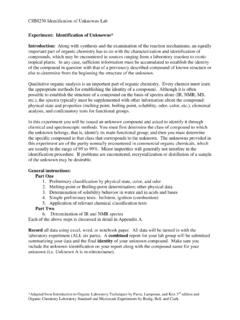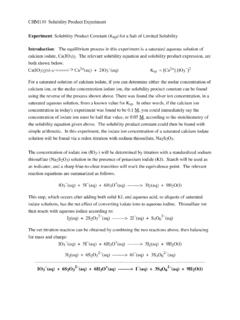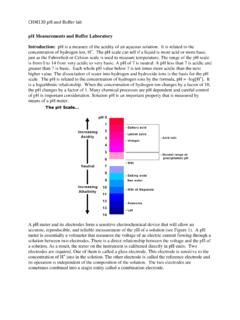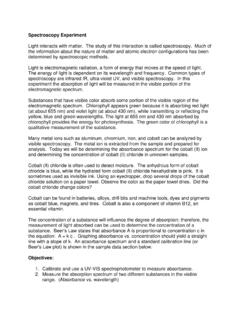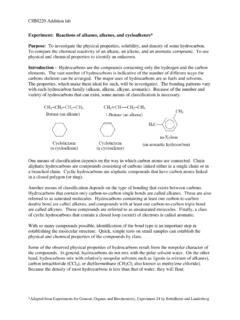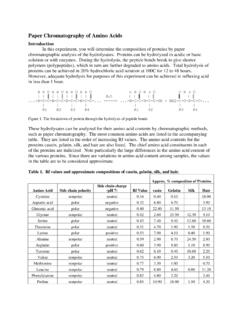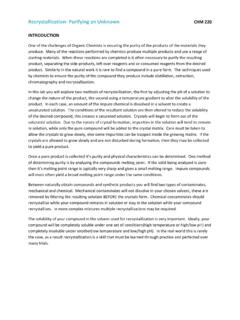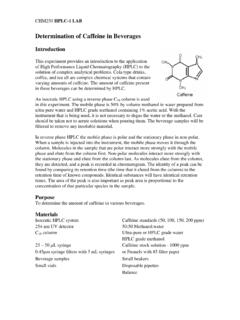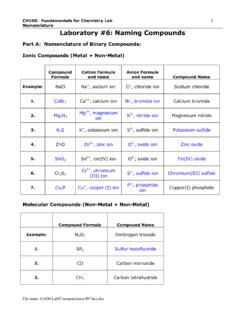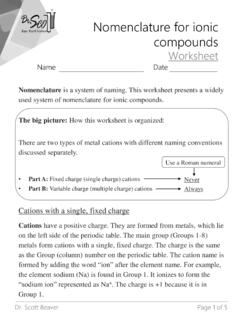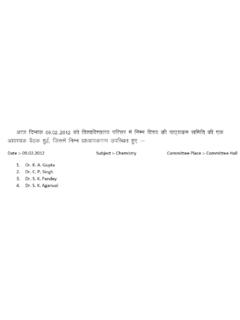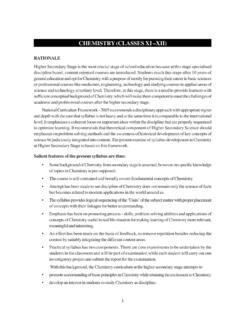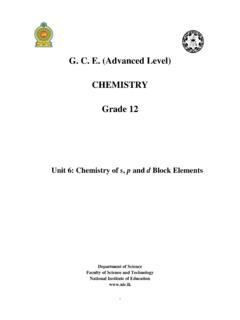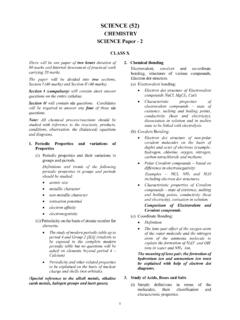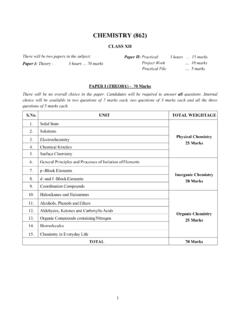Transcription of Determining the Formula of a Hydrate
1 Determining the Formula of a Hydrate A Hydrate is an ionic compound that has a definite amount of water molecules attached to its crystalline structure. The ratio of water molecules to the anhydrous salt is constant. Many compounds exist as hydrates. Some examples are copper (II) sulfate, sodium sulfate, nickel (II) sulfate, iron (II) sulfate, cobalt (II) chloride, magnesium sulfate, sodium carbonate, calcium sulfate, sodium acetate, and barium chloride. The Hydrate Na2S2O3 . 5 H2O is used in photography to fix negatives during the development of photographs. Five water molecules are attached to every sodium thiosulfate molecule. Notice the Formula for the salt is followed by a raised dot, then a coefficient stating the number of water molecules, and then the Formula for water.
2 The raised dot means that the water molecules are loosely attached to the ionic compound . This Hydrate Na2S2O3 . 5 H2O is named sodium thiosulfate pentahydrate. The name of the anhydrous salt is followed by a prefix indicating the number of water molecules followed by the word Hydrate . In this experiment the hydrates of copper(II) sulfate, CuSO4 . x H2O, and magnesium sulfate, MgSO4 . x H2O, will be studied. The water molecules are loosely attached to the salt and can be removed upon heating yielding the anhydrous salt (salt without water). The mass of water lost during heating can be determined and the coefficient x can be calculated from the ratio of moles of anhydrous salt to moles of water.
3 Hydrate --- ---> anhydrous salt + water The symbol represents heat. Sometimes a color change occurs when a colored Hydrate is heated. However a color change does not usually occur for white crystalline hydrates. This experiment will also illustrate the law of conservation of mass and the law of definite proportions. The law of conservation of mass states that the total mass remains constant during a chemical change or chemical reaction. Atoms are not destroyed, created, or broken down during a chemical reaction. A chemical reaction only rearranges the combination of atoms. The total mass remains constant. Mass of substances before reaction = Mass of substances after reaction In this experiment: mass of Hydrate = mass of H2O lost + mass of anhydrous salt after heating The law of definite proportions or constant composition states that the elements in a pure compound are present in a definite constant mass.
4 For example, every molecule of water has 2 hydrogen atoms for every one oxygen atom OR a mole of H2O has grams hydrogen for every grams oxygen. The Hydrate Na2S2O3 . 5 H2O has a constant composition of 5 moles H2O for every 1 mole Na2S2O3. Objectives: 1. Calculate the molar mass of a compound 2. Convert grams to moles 3. Determine the Formula of a Hydrate 4. Determine the mass percentage of water in a Hydrate 5. Understand the law of definite composition and law of conservation of mass Prior to lab read the sections of our textbook that discuss the topics: moles, molar mass, hydrates, percent composition, and the law of definite composition. Chemicals: Hydrates: CuSO4 . x H2O and MgSO4.
5 X H2O Equipment: Evaporating Dish Crucible tongs Clay triangle Ring clamp Wire gauze Porcelain Spatula Bunsen burner Analytical balance Sample Calculation: A gram sample of cobalt (II) chloride Hydrate CoCl2 . x H2O was heated carefully. After heating, grams of the anhydrous salt CoCl2 remained. a) What is the Formula of the Hydrate ? First determine mass H2O, next calculate moles H2O, then calculate moles of anhydrous salt Mass of H2O = Mass Hydrate - Mass anhydrous salt = g = grams H2O Molar mass of H2O = [ 2 H atoms x ] + [ 1 oxygen atom x ] = + = grams Moles H2O = g x 1 mole H2O / g = moles H2O Molar mass of CoCl2 = [ 1 Co atom x ] + [ 2 Cl atoms x ] = + = grams Moles of CoCl2 = g x 1 mole CoCl2 / g = moles CoCl2 Ratio moles H2O to moles CoCl2 = moles H2O / moles CoCl2 = 6 moles H2O to 1 mole CoCl2 Formula of Hydrate is CoCl2.
6 6 H2O b) What is the mass percent of H2O in the Hydrate ? Percent H2O = Mass H2O / Mass Hydrate x 100 = ( g / g) x 100 = % H2O This experiment contains several parts. Each part is described in the instructions. An Excel spreadsheet will be used to enter collected data and calculations. The parts to the experiment are: 1. Safety precautions 2. Preparing the evaporating dish 3. Heating the Hydrate 4. Lab Cleanup Download the Data Spreadsheet Safety precautions: Wear safety goggles. Do not touch the hot dish or iron ring with your hands. Always use tongs. Do not set a hot dish on the cool countertop. When working with the Bunsen burner, tie back long hair. Secure loose clothing such as drawstrings from sweatshirts.
7 Preparing the evaporating dish: 1. Wash the evaporating dish with soap. Rinse with water. Dry with paper towels. 2. Prepare the setup as shown by instructor. [The ring clamp and wire gauze should be several inches above the bunsen burner. Place the clean dish on the wire gauze.] 3. Using the hottest part of the flame, heat the empty clean evaporating dish for 5 minutes. The wire gauze may have a red glow. 4. Do not touch the hot dish or iron ring with your hands. With the tongs, remove the dish and place it on a clay triangle. Cool for 5 minutes. 5. Mass the cooled evaporating dish and record the mass to +/- grams. WRITE ALL of the digits from the balance reading. The mass of the empty dish is CRITICAL to the results.
8 If there is any doubt as to whether the dish is completely dry, repeat the heating, cooling, and weighing steps. Heating the copper (II) sulfate Hydrate : 1. Use the SAME analytical balance for the entire experiment. Place the cooled evaporating dish on the balance. Add about grams copper(II) sulfate Hydrate to the dish. REWEIGH the dish and Hydrate . RECORD the mass of the dish and Hydrate to +/- grams. WRITE ALL of the digits from the balance reading. 2. Place the dish containing the Hydrate on the wire gauze. Gently heat the dish by moving the burner back and forth around the base. 3. Heat strongly for 5 minutes or longer until the blue color disappears. Use a microspatula to spread out and break up "clumped" portions of the Hydrate , so that 'trapped' water molecules can evaporate.
9 Do not remove any of the solid with the spatula. If the edges of the Hydrate begin to brown, remove the heat momentarily. Heat again at a gentler rate. 4. With the tongs, remove the dish and place it on a clay triangle. Allow the dish to cool for 3 minutes. Immediately mass the dish and anhydrous salt. Record the mass to +/- grams. 5. Heat again for 5 minutes. With tongs, place it on a clay triangle. 6. Allow the dish to cool for 3 minutes. Immediately mass and record the mass to +/- grams. 7. If the masses after the first and second heating do not agree to within +/- grams, heat a third time, cool, and weigh again. Heating the magnesium sulfate Hydrate : 1. Clean and prepare a second evaporating dish by washing it, drying it, and heating it as described in the section titled "Preparing the evaporating dish".
10 2. Record the mass of the clean cooled evaporating dish under the heading for MgSO4 . Record the mass to +/- grams. WRITE ALL of the digits from the balance reading. 3. Repeat the entire experiment and record the data using grams of magnesium sulfate Hydrate (known as Epsom salt), instead of copper (II) sulfate Hydrate . Follow the procedure listed above for heating the Hydrate and record the mass after each heating. Lab Cleanup: 1. Let the iron ring and wire gauze cool till the end of lab and then place them in the lab drawer. 2. After completing the calculations, observe the color of the anhydrous salt. Did it change color? What does the color indicate? 3. Using a water bottle, spray a few drops of water on the copper sulfate Hydrate .
